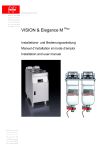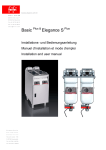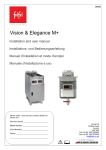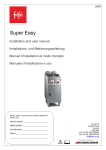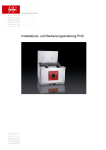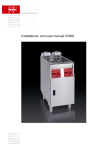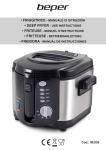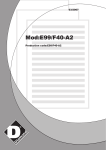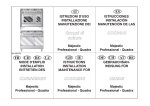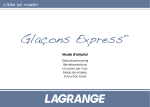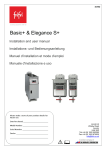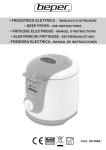Download Mode d'installation et d'emploi Profi plus
Transcript
Cooking Systems with Oil f r i f r i a r o S A Chemin de St. Joux 7 CH-2520 La Neuveville Tel +41 32 752 46 52 Fax +41 32 752 46 88 [email protected] Profi PLUS Installations- und Bedienungsanleitung Manuel d’installation et mode d’emploi Installation and user manual European Service a n d L o g i s t i c s C e n t e r f r i f r i Hauptsrasse 196 D-79739 Schwörstadt Tel +49 7762 - 805700 Fax +49 7762 - 805702 1. Beschreibung Description Description Fritierkorb Panier Frying basket Korbhalterung Fixation panier Basket holder Bedienpanel Commande Control panel Führungen für Steuerkasten Glissières pour le Sliding rail for boîtier de commande control box Anschlag für Sicherheits- Butée de détection Endschalter du switch Stop pin of the security switch Ablasshahn Vanne de vidange Drain valve Einlagegitter Profi 6-8 Grille Profi 6-8 Grid Profi 6-8 Einlagegitter Profi 10 Grille Profi 10 Grid Profi 10 Cuve Profi 6-8-10 Fritierkorb Panier a frire Frying basket Friteusendeckel Couvercle Cover lid Becken Profi 6-10 Cuve Profi 6-10 Frying pan Profi 6-10 2. Ausführungen und Abmessungen Typ Profi 6 Profi 6+6 Profi 8 Profi 8 + 8 Profi 10 Breite A 270 mm 540 mm 360 mm 720 mm 540 mm 2.1 Gewichte und Füllmengen Typ Profi 6 Profi 6+6 Profi 8 Profi 8 + 8 Profi 10 Nettogewicht ohne Optionen (kg) 13.5 24 16.5 30.5 23 Anzahl Körbe 1 2 0.75 2x 0.75 2x 0.75 Fritierölmenge Minimum (l) 5 2x 5 1 ou 2 2x 1 2x(2x 0.5) 2x8 2 Füllmenge des Fritierkorbes (Kg) 1 ou 2 1x 1 2x 0.5 8 Fritierölmenge Maximum (l) 7 2x 7 9.5 2 x 9.5 15 Stundenleistung TK – Frites (Kg) 12 24 18 36 20 Stundenleistung gekühlte – Frites (Kg) 14 28 22 44 25 2.2 Geräteidentifikation Jede Friteuse ist mit einer eindeutigen Geräteidentifikation versehen. Halten Sie bei jeder Anfrage an den Kundendienst die Geräteidentifikation bereit. 2.3 Umgebungsbedingungen Typ Temperatur mini. ( °C ) Temperatur max. ( °C ) Feuchtigkeit max.. ( %) Profi +5 + 60 60 12 2.4 Spannungen, Anschlussarten und Ausführungen Standardausführung Dreiphasig mit Neutral und Erdung Spezialausführung ohne Neutral Spannung 3~ 400 V 50/60Hz - 3L + PE Spannung 3N~ 400 V 50/60Hz - 3L + N + PE Spezialausführung für Schiff Spezialausführung Dreiphasig Spannung 3~ 440 V 50/60Hz - 3L + PE Spannung 3~ 230 V 50/60Hz - 3L + PE Spezialausführung Einphasig Spannung ~ 230V 50/60Hz - L + N + PE 2.5 Netzabsicherung Profi 8 / Profi 10 6.9 Kw Typ Profi 6 Leistung 4.6 Kw ~ 230V 31 A 40 A 3 x 17.3 A 3 x 23.9 A 2N~ 400V 20.8 A 10A – 17.3A – 10A 2 x 10A - - 3N~ 400V - 3 x 10 A 3 x 13.3 A 3 ~ 230V Profi 10 9.2 Kw 2.6 Elektrischer Anschluss Der Elektroanschluss darf nur durch einen Elektriker oder eine ähnlich qualifizierte Person erfolgen. Beim Anschluss des Gerätes ist wie folgt vorzugehen: a) Ueberprüfen, ob die Daten des Stromnetzes in Bezug auf Spannung und Frequenz mit den Angaben auf dem Typenschild des Gerätes übereinstimmen. Das Typenschild befindet sich hinter der Türe auf dem Abdeckblech. b) Anschluss nach EN 60335-1 und örtlichen Vorschriften, d.h.: Montage eines Netzsteckers für entsprechende Nennstromstärke an das Anschlusskabel, Anschluss über Steckdose. Der Stecker muss nach der Montage der Friteuse zugänglich sein. Es ist empfehlenswert einen Fehlerstromschutzschalter zu installieren. (bei Maschinen, die die Ableitströme von 10mA überschreiten). Bei Festanschluss ist ein Hauptschalter für allpolige Trennung mit einem Kontaktabstand von min. 3 mm vorzusehen. Der Elektroanschluss muss mindestens einer Gummischlauch-Leitung, Typ H05RN-F, entsprechen. c) Erlaubt "die Erdung des Gerätes (oder Schutzleiter). Sie ist unentbehrlich für Ihre Einrichtung. Vervollständigt durch eine Differentialvorrichtung schützt sie die Benutzer, wenn ein Fehler an einem Gerät vorkommt. Der Fehlerstrom läuft in Richtung Erde aus und verursacht die Auslösung des Differentials." d) Wenn die Netzanschlussleitung dieses Gerätes beschädigt wird, muss sie durch den Hersteller oder seinen Kundendiest oder eine ähnlich qualifizierte Person ersetzt werden, um Gefährdungen zu vermeiden. 3. Sicherheitsvorschriften und Warnhinweise Die folgenden Warnsymbole sind ggf. an der Friteuse angebracht: Hochspannung Warnung vor gefährlicher elektrischer Spannung. Stromschläge führen zu schweren Verletzungen oder zum Tod. Nur autorisiertes Fachpersonal darf Arbeiten an elektrischen Installationen durchführen. Befolgen Sie die fachspezifischen Sicherheitsvorschriften! Trennen Sie die Friteuse vom Netz, bevor Sie Arbeiten an elektrischen Installationen durchführen. Heisse Oberfläche / Heisse innere Bauelemente Warnung vor Hitze, die zu Verletzungen führen kann. Lassen Sie heisse Oberflächen und Bauteile abkühlen, bevor Sie Arbeiten an diesen Bauelementen ausführen oder tragen Sie hitzefeste Handschuhe. Heisses Frittieröl Warnung vor heissem Frittieröl, das zu Verletzungen führen kann. Lassen Sie das heisse Frittieröl abkühlen, bevor Sie Arbeiten an eingetauchten Bauelementen ausführen oder tragen Sie eine Brille. HINWEIS Der Hersteller hat zum Zeitpunkt der Auslieferung der Friteuse ggf. an allen relevanten Orten der Friteuse Warnsymbole (Kleber) angebracht. Sollten sich während des Betriebs der Friteuse oder im Zuge von Reinigungsarbeiten Warnsymbole ablösen, ist der Betreiber der Friteuse gehalten, diese Warnsymbole umgehend neu aufzukleben ! 3.1 Bestimmungsgemässe Verwendung der Friteuse Die Friteuse dient ausschliesslich zum Fritieren von frischen und tiefgekühlten Nahrungsmitteln, welche beim durchgeführten Frittierungsprozess weder personen-, noch sach- und umweltgefährdend reagieren. Die Friteuse ist ausschliesslich für den beaufsichtigten Betrieb zugelassen. Eine andere Benutzung der Friteuse gilt als nicht Bestimmungsgemäss. Zur Bestimmungsgemässen Verwendung gehört auch das Beachten der Betriebsanleitung und das Einhalten der vom Hersteller vorgeschriebenen Wartungs- und Instandsetzungsvorschriften. 3.2 Spezifische Gefahren und Weisungen ACHTUNG Die Friteuse ist ausschliesslich für den beaufsichtigten Betrieb zugelassen. Enthält der Ölauffangbehälter heisses Frittieröl müssen bei dessen Handhabung Schutzkleidung, Schutzhandschuhe und Schutzbrille getragen werden. Die Friteuse niemals mittels Wasser aus einer Brause, einem Wasserschlauch oder Hochdruckreiniger abspritzen. Es besteht Brandgefahr bzw. der Sicherheitsthermostat schaltet die Friteuse ab, wenn die Friteuse ohne vorheriges Einfüllen von Fett oder Frittieröl bis über die untere Ölstandmarke in Betrieb gesetzt wird. Während des Betriebs darf der Frittierölstand nicht unter die untere Ölstandmarke absinken. Es besteht Brandgefahr bzw. der Sicherheitsthermostat schaltet die Friteuse ab. Während des Betriebs darf der Frittierölstand nicht über die obere Ölstandmarke ansteigen. Es besteht beim Eintauchen von Frittiergut Überlauf- bzw. Überschäumgefahr. Abgenutztes, verunreinigtes Frittieröl ist erhöht entzündlich und neigt zum überschäumen. Bei einem Frittierölbrand niemals mit Wasser einen Löschversuch einleiten, sondern sofort die Frittier-beckenabdeckung auflegen oder einen Feuerlöscher mit spezieller Füllung (Halon) bzw. eine Löschdecke einsetzen. ACHTUNG Einbringen von zu viel gefrorenem oder zu nassem Frittiergut in das heisse Frittieröl führt zu Aufschäumen des heissen Frittieröls und mindert die Qualität der frittierten Nahrungsmittel. Die Standfriteuse nicht im aufgeheizten Zustand verschieben. Es besteht Überschwappgefahr des heissen Frittieröls. Beim Frittierölablassen muss das Frittieröl auf eine Temperatur unter als 70 °C abgekühlt sein (Verbrennungsgefahr). Tauchheizung niemals mittels Stahlbürste oder durch Abbrennen (Trockenlauf) reinigen. Nachweislich unsachgemässe Reinigung der Tauchheizung schliesst allfällige Gewährleistungsansprüche aus. . 3.3 Personensicherheit ACHTUNG Die Friteuse kann bei falscher Bedienung schwere oder tödliche Verletzungen des Personals verursachen. Das Personal, das die Friteuse bedient und wartet, muss für den korrekten Umgang mit der Friteuse geschult sein und muss die Sicherheitsvorschriften in dieser Betriebsanleitung gelesen und verstanden haben, bevor mit der Bedienung oder der Wartung der Friteuse begonnen wird. Verändern oder entfernen Sie nie Sicherheitseinrichtungen. Schalten Sie keine Sicherheitseinrichtungen durch Veränderungen an der Friteuse aus. Entfernen Sie nie Warnsymbole, welche ggf. an der Friteuse angebracht sind (nationalitätsabhängig). Ersetzen Sie fehlende oder defekte Warnsymbole umgehend. Betreiben Sie die Friteuse nie in schadhaftem Zustand. Melden Sie Unregelmässigkeiten, insbesondere solche, die die Sicherheit betreffen, sofort Ihrem Vorgesetzten. 3.4 Sicherheitseinrichtungen Nebst den an der Friteuse ggf. angebrachten Warnsymbolen (nationalitätsabhängig) verfügt die Friteuse über folgende Sicherheitseinrichtungen: Hauptschalter Sicherheitsrelais Sicherheitsthermostat 3.5 Autorisierte Personen An und mit der Friteuse dürfen nur Personen arbeiten, die für die jeweiligen Arbeiten autorisiert sind. Die Personen sind dann autorisiert, wenn sie die in diesem Kapitel aufgelisteten minimalen Ausbildungs- und Wissensanforderungen erfüllen und Ihnen ein fester Aufgabenbereich zugeteilt ist. "Dieses Gerät ist nicht dafür bestimmt, durch Personen (einschliesslich Kinder) mit eingeschränkten physischen, sensorischen oder geistigen Fähigkeiten oder mangels Erfahrung und/oder mangels Wissen benutzt zu werden, es sei denn, sie werden durch eine für ihre Sicherheit zuständige Person beaufsichtigt oder erhielten von ihr Anweisungen, wie das Gerät zu benutzen ist. Kinder sollten beaufsichtigt werden, um sicherzustellen, dass sie nicht mit dem Gerät spielen." 3.6 Aufgabenbereich des Personals 3.6.1 Betreiber Als übergeordnete juristische Person ist der Betreiber verantwortlich für die bestimmungsgemässe Verwendung der Friteuse und für die Ausbildung sowie den Einsatz der berechtigten Personen. Er legt die Kompetenzen und Weisungsbefugnisse der berechtigten Personen für seinen Betrieb fest. 3.6.2 Bediener der Friteuse Ihm obliegen folgende Arbeiten: Er richtet die Friteuse auf die aktuell zu frittierenden Nahrungsmittel ein bzw. um, falls er andere Nahrungsmittel verarbeiten möchte als jene, die der Lieferant bei Lieferung der Friteuse eingerichtet hat. Er beschickt die Friteuse mit den zu frittierenden Nahrungsmitteln. Er fährt die Prozesse an und überwacht diese. Er lokalisiert Probleme und organisiert die Problembehebung. Er füllt Frittieröl in die Friteuse ein. Er überwacht die Frittierölqualität und führt Frittierölnachfüllung, -reinigung und -filtrierung durch. 3.6.3 Unterhaltspersonal Ihm obliegen folgende Arbeiten: Es reinigt, wartet und repariert die Friteuse entsprechend den Kapiteln „Wartung und Störungsbehebung“. Es demontiert, lagert und entsorgt die Friteuse. . 3.7 Minimale Ausbildung und Qualifikation des berechtigten Personals 3.7.1 Betreiber Er ist eine betriebswirtschaftlich ausgebildete Person in Kaderfunktion. Er hat einschlägige Erfahrung in der Gefahrenbeurteilung und Personalführung. Er hat das Kapitel Sicherheitsvorschriften gelesen und verstanden. 3.7.2 Bediener der Friteuse Dies ist eine Person, welche über die Bedienung der Friteuse instruiert und über die bestehenden Gefahren orientiert ist. 3.7.3 Unterhaltspersonal Dies sind Personen, welche eine einschlägige Berufslehre absolviert haben und mit dem Unterhalt der Friteuse vertraut sind und durch ihre Tätigkeit über die entsprechenden Qualifikationen verfügen. Unterhaltsarbeiten an der elektrischen Ausrüstung der Friteuse dürfen nur von einer Elektrofachkraft oder von unterwiesenen Personen unter Leitung und Aufsicht einer Elektrofachkraft gemäss den elektrotechnischen Regeln vorgenommen werden. 3.8 Wartungspflicht Der Betreiber ist verpflichtet, die Friteuse in regelmässigen Abständen zu warten und zu reinigen. Die Friteuse nur in einwandfreiem und unbeschädigtem Zustand betreiben. Nur Originalverbrauchsmaterial und Originalersatzteile verwenden. Nach Wartungs- und Instandsetzungsarbeiten die Sicherheitseinrichtungen auf korrekte Funktion prüfen. 3.9 Verfügbarkeit der Bedienungsanleitung Ein Exemplar dieser Betriebsanleitung muss dem Personal jederzeit am Einsatzort der Friteuse zur Verfügung stehen. 4. Installation und Inbetriebnahme 4.1 Installation des Gerätes Bei der Installation des Gerätes sind folgende Punkte zu beachten: Der Elektroanschluss darf nur durch einen Elektriker oder eine ähnlich qualifizierte Person erfolgen. Beim Anschluss des Gerätes ist wie folgt vorzugehen: a) Ueberprüfen, ob die Daten des Stromnetzes in Bezug auf Spannung und Frequenz mit den Angaben auf dem Typenschild des Gerätes übereinstimmen. Das Typenschild befindet sich auf der Rückseite des Steuerkasten. b) Anschluss nach EN 60335-1 / IEC bzw. CEI 335-1 und örtlichen Vorschriften, d.h.: Montage eines Netzsteckers für entsprechende Nennstromstärke an das Anschlusskabel, Anschluss über Steckdose. Der Stecker muss nach der Montage der Friteuse zugänglich sein. Es ist empfehlenswert einen Fehlerstromschutzschalter zu installieren. (bei Maschinen, die die Ableitströme von 10mA überschreiten). c) Zu verwendende Qualität der Zuleitung: H07RN-F 4.2 Inbetriebnahme nach der Installation Entfernen Sie alle allfällig noch vorhandenen Verpackungsrückstände. Gerätedeckel von Ölbecken entfernen und Korb aus Ölbecken nehmen. Reinigen Sie das Ölbecken, den Frittierkorb sowie allfälliges weiteres Zubehör mit einem Lebensmittel verträglichen Reinigungsmittel. ABLASSHAHN SCHLIESSEN. Ölbecken bis zur Markierung MAX mit Frittieröl auffüllen oder Frittierfett auf die Heizelemente legen. Die Niveaumarkierung (MIN/MAX) ist auf Seitenwand des Ölbeckens zu sehen. Achtung: Bei Fettgebrauch auf Position Fettschmelzzyklus immer Fisch- oder Heizkörpergitter entfernen. Fett muss in direktem Kontakt mit dem Heizkörper sein. 5 Bedienung der Friteuse 5.1 Bedienpanel Start / Stop Pumpe Reset / Initialisierung Sicherheitsthermostat Kontroll Lampe Heizung Ein / AUS Schalter Regelthermostat 5.2 Bedienen der Steuerung Nach dem anschliessen an das Stromnetz muss der Sicherheitsthermostat initialisiert werden. Mit der EIN Taste wird das Bedienpanel unter Spannung gesetzt. Die grüne LED Lampe signalisiert dass das Panel Betriebsbereit ist. Die „Standby“ Position ist gleichzeitig der Fettschmelzzyklus. Dieser ermöglicht Fett / Oel schonend auf 60°C aufzuheizen. Die Heizung wechselt zwischen einer Heiz- und Ruhephase. Somit wird Fett schonend verflüssigt und Fett / Oel ohne Rauchentwicklung aufgewärmt und deren Lebensdauer erhöht. Die Orange LED „Heizmodus“ blickt während der Aufheizphase. Sobald die Endtemperatur erreicht ist bleibt das LED konstant. Die Anwahl der gewünschten Frittiertemperatur erfolgt mittels drehen des Wahlschalters auf eine . Hinweis: Die Funktion „Standby“ läuft automatisch im Hintergrund ab auf 60°C und heizt erst danach mit voller Leistung auf die eingestellte Temperatur. Die Orange LED „Heizphase“ blinkt während dem aufheizen. Sobald die eingestellte Temperatur erreicht ist, wird die LED fix. Zum Abschalten der Friteuse: . Drehen sie den Wahlschalter in Position „0“ . Drücken Sie die „OFF“ Taste. Die grüne LED erlischt und das Bedienpanel ist nun ausser Betrieb. Hinweis: Bei jeder Handhabung des Steuerkastens muss das Bedienpanel ausser Betrieb sein. 6. Reinigung, Unterhalt 6.1 Reinigungsarbeiten, täglich oder je nach Einsatzdauer des Gerätes ACHTUNG Ausschliesslich nichtätzende, nichtscheuernde Reiniger verwenden. Ausschliesslich nichtscheuernde Lappen verwenden. Ausschliesslich Reiniger verwenden, welche im Lebensmittelbereich zugelassen sind. Reinigungsarbeiten immer erst durchführen, wenn das Frittieröl und die Friteuse auf eine Temperaturniveau abgekühlt haben bei dem keine Verbrennungen entstehen können. Reinigungsbereich Äussere Flächen und Abdeckungen Bedientableau inklusive aller Bedienelemente Schnellkupplung (Option Pumpe) Fritierbecken Fritierkorb Fritierkorbhalter Fritierölbeckenabdeckung Innere Flächen und Abdeckungen Anschlusskabel Ölauffangbehälter Fritteusenumfeld Reinigungsarbeiten Mittels feuchtem Lappen reinigen Mittels feuchtem Lappen reinigen Reinigungsmittel/ Heisses Wasser Reinigungsmittel/ Heisses Wasser Spülmaschine/ Heisses Wasser Spülmaschine/ Heisses Wasser Spülmaschine/ Heisses Wasser Mittels feuchtem Lappen reinigen Mittels feuchtem Lappen reinigen Spülmaschine/ Heisses Wasser Säubern Sie mit harter und weicher Bürste und feuchten Tüchern und befolgen Sie Spezialanweisungen wenn notwendig 6.2 Intervalle des Frittierölwechsel Filtrieren Erneuern - Auswechseln Täglich bzw. je nach Gebrauchsintensität Je nach Abnutzung und Sättigung 6.3 Periodische Kontrollen Ölauffangbehälter Frittierölqualität Frittierbecken Einlaufbogen und Schnellkupplung Tauchheizung Sauberkeit, Füllstand Gemäss Hygienevorschriften Sauberkeit, abgesunkene Fritiergutreste Sauberkeit, Funktion, Dichtheit Oberfläche 6.4 Wartung Wir empfehlen einen regelmässigen Unterhalt durch einen Kundendienst machen zu lassen, je nach Gebrauchsintensität des Gerätes. Gelegentlicher Gebrauch Mittlerer Gebrauch Intensive Nutzung Weniger als 8 h pro Tag 8 bis 12 h pro Tag Mehr als 12 h pro Tag Einen Unterhaltsdienst pro Jahr 1 bis 2 Unterhaltsdienste pro Jahr 1 Zwischenservice sowie einen Basisdienst pro Jahr 7. Kundendienst Wenden Sie sich bei Betriebsstörungen an ihren Händler oder an die nächste Servicestelle. Vermeiden Sie aber Fehlmeldungen und prüfen Sie deshalb vor Anforderung eines Monteurs, ob - die Sicherungen der elektrischen Zuleitung intakt sind - der Stecker eingesteckt ist - der Apparat richtig in Betrieb gesetzt wurde - Oelstand kontrollieren, eventuell unter MIN-Markierung Wichtig ! Bitte geben Sie bei jeder Meldung an die Servicestelle den Apparatetyp und die Apparatenummer an, die Sie auf dem Datenschild am Panel hinter der Türe finden. 2. Exécutions, variantes et mesures Type Profi 6 Profi 6+6 Profi 8 Profi 8 + 8 Profi 10 Largeur A 270 mm 540 mm 360 mm 720 mm 540 mm 2.1 Poids et contenances Type Profi 6 Profi 6+6 Profi 8 Profi 8 + 8 Profi 10 Poids net, sans accessoires (kg) 13.5 24 16.5 30.5 23 Nombre de Panier 1 2 0.75 2x 0.75 2x 0.75 Quantité d’huile niveau minimum (l) 5 2x 5 1 ou 2 2x 1 2x(2x 0.5) 2x8 2 Capacité par panier de friteuse (Kg) 1 ou 2 1x 1 2x 0.5 8 Quantité d’huile niveau maximum (l) 7 2x 7 9.5 2 x 9.5 15 Rendement par heure de frites congelées (Kg) 12 24 18 36 20 Rendement par heure de frites précuites (Kg) 14 28 22 44 25 12 2.2 Identification de l’appareil Chaque friteuse est dotée d'une plaquette technique pour l’identification de l'appareil. Toujours mentionner cette identification d'appareil lorsque vous faites appel au service après-vente. 2.3 Conditions ambiantes Type Température mini. ( °C ) Température max. ( °C ) Humidité max.. ( %) Profi +5 + 60 60 2.4 Tensions, type de raccordement et exécutions Exécution standard triphasée avec Neutre Exécution spéciale sans neutre Tension triphasée 3~ 400 V 50/60Hz - 3L + PE Tension triphasée 3N~ 400 V 50/60Hz - 3L + N + PE Exécution spéciale pour bateau Exécution spéciale triphasée Tension triphasée 3~ 440 V 50/60Hz - 3L + PE Tension triphasée 3~ 230 V 50/60Hz - 3L + PE Exécution spéciale monophasée Exécution spéciale deux phases avec Neutre Tension triphasée ~ 230V 50/60Hz - L + N + PE Tension triphasée 2N~ 400 V 50/60Hz - 2L + N + PE 2.5 Fusible d’alimentation Profi 8 / Profi 10 6.9 Kw Profi 10 Type Profi 6 Puissance 4.6 Kw ~ 230V 31 A 40 A 3 x 17.3 A 3 x 23.9 A 2N~ 400V 20.8 A 10A – 17.3A – 10A 2 x 10A - - 3N~ 400V - 3 x 10 A 3 x 13.3 A 3 ~ 230V 9.2 Kw 2.6 Raccordement électrique Le raccordement électrique doit être fait par un électricien ou une autre personne qualifiée qui assurera une installation conforme aux normes. Procédez comme suit: a) Vérifiez si les spécifications du réseau électrique correspondent à celles indiquées sur la plaquette signalétique de la machine. Cette plaquette se trouve sur le panneau derrière la porte. b) Raccordement selon normes IEC resp. CEI 335-1 et prescriptions locales, c'est-à-dire : Montage d'une fiche sur le câble d’alimentation, elle doit être dimensionnée à la puissance et au courant nominal de la friteuse. La fiche doit être accessible après l’installation de la friteuse. En amont de l’alimentation de la friteuse, un disjoncteur de courant de fuite (FI : 10mA de courant de fuite) est recommandé. Prévoir lors de l'installation un interrupteur principal à proximité de la friteuse, avec séparation de tous les pôles, écartement des contacts 3 mm au minimum. Le câble de raccordement doit être au moins un câble du type H07RN-F. c) Permet le raccordement de la terre (ou conducteur de protection), elle est indispensable à votre installation. Complétée par un dispositif différentiel, elle protège les utilisateurs lorsqu'un défaut survient à un appareil. le courant de défaut s'écoule vers la terre et provoque le déclenchement du différentiel. d) Si la conduite de raccordement au secteur de cet appareil est endommagée, elle doit être remplacée par le fabricant ou son service après vente ou une personne qualifiée tout aussi pour éviter des risques . 3. Prescriptions de sécurité Les symboles suivants sont éventuellement appliqués sur la friteuse: Haute tension Avis de tension électrique dangereuse. Décharges électriques provoquant des lésions graves ou la mort. Les interventions sur les installations électriques doivent être assurées uniquement par des techniciens autorisés. Respectez les prescriptions de sécurité spécifiques à ce domaine d'activité ! Débranchez la friteuse du secteur avant de procéder à des interventions sur les installations électriques. Surface chaude / Constituants intérieurs chauds Avis de chaleur pouvant conduire à des blessures. Laissez les surfaces et les constituants chauds se refroidir avant d'intervenir dessus ou portez des gants anti-chaleur Huile de friture chaude Avis d'huile de friture chaude pouvant conduire à des blessures. Laissez l'huile de friture chaude se refroidir avant d'intervenir sur des constituants immergés ou portez des lunettes NOTA Au moment de la livraison de la friteuse, tous les symboles d'avertissement (autocollants) correspondants ont été apposés par le fabricant aux emplacements appropriés. Si des symboles d'avertissement sont défaits pendant l'utilisation de la friteuse ou au cours d'opérations de nettoyage, l'exploitant de la friteuse est tenu de remplacer immédiatement! 3.1 Utilisation conforme de la friteuse La friteuse sert exclusivement à faire frire des denrées alimentaires fraîches ou surgelées qui ne manifestent pas de réactions constituant des risques corporels, matériels et environnementaux lors du processus de friture. La friteuse est homologuée uniquement pour une utilisation sous surveillance. Toute autre utilisation de la friteuse est considérée comme non conforme. L'utilisation conforme implique également le respect du mode d'emploi et des prescriptions de maintenance et de réparation établies par le fabricant. 3.2 Dangers et consignes spécifiques AVERTISSEMENT La friteuse est homologuée uniquement pour une utilisation sous surveillance. Si le bac de récupération d'huile contient de l'huile de friture chaude, il faut porter des vêtements, des gants et des lunettes de protection lors de son maniement. Ne jamais asperger la friteuse avec le jet d'eau d'une douche, d'un flexible ou d'un nettoyeur haute pression. La mise en service de la friteuse avant son remplissage préalable de graisse ou d'huile de friture au-dessus du niveau MIN représente un risque d'inflammation ou conduit à une coupure de la friteuse par le thermostat de sécurité. L'huile ne doit pas descendre en dessous du niveau MIN pendant l'utilisation. Cela représente un risque d'inflammation ou conduit à une coupure de la friteuse par le thermostat de sécurité. L'huile ne doit pas dépasser le niveau MAX pendant l'utilisation. Cela constitue sinon un risque de débordement d'huile ou de mousse lors de l'immersion du produit à frire. L'huile de friture usagée et dégradée est plus facilement inflammable et tend à la saturation (mousse). Ne jamais lutter contre une inflammation d’huile avec de l’eau. Fermer immédiatement le couvercle de la cuve ou utiliser un extincteur à agent spécial (halon) ou une couverture anti-feu. ATTENTION Un panier rempli de produits trop humides ou trop surgelés (avec des cristaux de glace) provoque un moussage abondant de l’huile chaude, ce qui porte préjudice à la qualité la friture et un risque de débordement. Ne pas déplacer la friteuse lorsque l’huile est chaude. Cela constitue un risque de débordement de l'huile de friture chaude. Pour vidanger ou pomper de l'huile de friture, celle-ci doit être refroidie à une température ne dépassant pas 175 °C. Ne jamais nettoyer le chauffage par immersion à l'aide d'une brosse métallique ou par pyrolyse (marche à sec). Tout nettoyage non conforme avéré du chauffage par immersion exclut toute prestation de garantie. 3.3 Sécurité des personnes AVERTISSEMENT En cas d'utilisation erronée, la friteuse peut occasionner des lésions graves ou mortelles. Le personnel qui utilise et entretient la friteuse doit être formé à son maniement correct et doit avoir lu et compris les instructions de sécurité du présent mode d'emploi avant de commencer à utiliser ou à entretenir la friteuse. Ne jamais modifier ou retirer des dispositifs de sécurité. Ne pas couper des dispositifs de sécurité en procédant à des modifications sur la friteuse. Ne jamais retirer des symboles d'avertissement apposés sur la friteuse (selon les pays). Remplacer immédiatement les symboles d'avertissement manquants ou défectueux. Ne jamais utiliser une friteuse en mauvais état. Signaler immédiatement à son supérieur hiérarchique de toutes les irrégularités, surtout celles qui concernent la sécurité. Pour remplacer des composantes électriques et mécaniques, séparer la friteuse du secteur électrique. Vérifier toutes les fonctions de sécurité une fois les opérations d'entretien terminées. 3.4 Dispositifs de sécurité En plus des symboles d'avertissement apposés sur la friteuse (selon les pays), la friteuse est dotée des dispositifs de sécurité suivants: Interrupteur principal Contacteur de sécurité Thermostat de sécurité 3.5 Personnes autorisées Seules peuvent travailler sur et avec la friteuse des personnes autorisées pour le travail concerné. Pour être autorisées, les personnes doivent remplir les exigences minimales de formation et de connaissance énumérées dans ce chapitre et s'être vues attribuer un domaine de compétence défini. "Cet appareil n'est pas prévu à l'usage des personnes (enfants y compris) avec des possibilités physiques, sensorielles ou mentales réduites, ou le manque d'expérience et de connaissance, à moins qu'ils aient été donnés la surveillance ou l'instruction au sujet de l'utilisation de l'appareil par une personne chargée de leur sûreté. Des enfants devraient être dirigés pour s'assurer qu'ils ne jouent pas avec l'appareil." 3.6 Domaine de compétence du personnel 3.6.1 Exploitant Personne juridiquement responsable, l'exploitant est responsable de l'utilisation conforme de la friteuse ainsi que de la formation et de l'affectation des personnes autorisées. Il définit les compétences et les domaines d'attribution des personnes autorisées pour son entreprise. 3.6.2 Utilisateur de la friteuse Les tâches suivantes lui sont attribuées : Il remplit d'huile de friture la friteuse. Il surveille la qualité de l'huile de friture et procède à sa remise à niveau, à sa purification et à son filtrage. Il démarre et surveille la friture. Il prépare la friteuse pour le produit à frire Il alimente la friteuse en produits à frire. Il localise les problèmes et organise leur élimination. 3.6.3 Personnel d'entretien Les tâches suivantes lui sont attribuées: Il nettoie, entretient et répare la friteuse conformément aux opérations décrites aux chapitres "Maintenance et Dépannage". Il démonte, entrepose et élimine la friteuse. 3.7 Formation et qualification minimales du personnel autorisé 3.7.1 Exploitant C'est une personne formée dans la gestion d'entreprise exerçant une fonction d'encadrement. Il possède l'expérience correspondante dans l'évaluation des risques et la gestion du personnel. Il a lu et compris le chapitre "Prescription de sécurité". 3.7.2 Utilisateur de la friteuse C'est une personne qui est instruite sur l'utilisation de la friteuse et qui est sensibilisée aux risques potentiels. 3.7.3 Personnel d'entretien Ce sont des personnes qui ont suivi une formation professionnelle correspondante, qui sont familiarisées avec l'entretien de la friteuse et qui disposent des qualifications correspondantes du fait de leur activité. Les opérations d'entretien sur l'équipement électrique de la friteuse doivent être réalisées uniquement par un électricien ou par une personne instruite sous la conduite et la surveillance d'un électricien conformément aux règles de l'électrotechnique. 3.8 Obligation de maintenance L'exploitant est tenu d'assurer la maintenance et le nettoyage de la friteuse à intervalles réguliers. La friteuse doit être utilisée uniquement en parfait état, c'est-à-dire sans dommage. Utiliser uniquement des consommables ou des pièces de rechange d'origine. Vérifier le bon fonctionnement des dispositifs de sécurité après des opérations de maintenance et de réparation. 3.9 Disponibilité du mode d'emploi Un exemplaire du mode d'emploi doit être tenu à tout instant à disposition du personnel sur le lieu d'utilisation de la friteuse. 4. Installation et Mise en service 4.1 Installation de l’appareil Lors de la mise en place de l’appareil veuillez tenir compte des points suivants : a) La friteuse doit être placée de niveau et sa hauteur doit être adaptée selon le désir de l’utilisateur. Facilement réalisable grâce aux quatre pieds réglables. La hauteur du plateau de la friteuse, par rapport au sol varie entre 850mm au minimum et 900 au maximum. b) Distance minimum à respecter entre l’arrière de la friteuse et la paroi murale ou avec un autre appareil: 30 mm. c) La friteuse ne doit pas reposer sur une surface inflammable, respectez les prescriptions de sécurité et de construction locales. d) La friteuse doit avoir un emplacement fixe. Si la friteuse est équipée avec l’option roulettes (2 roues fixes et 2 roues directionnelles), les freins des deux roues avants doivent être bloqués. Le rôle des roulettes est de faciliter l’entretien et le nettoyage de la friteuse. e) Il est toujours possible de modifier une friteuse exécution standard avec des pieds et de l’équiper avec l’option roulettes. Attention: En raison d’un équilibre insuffisant, les friteuses du type 211 & 311 ne peuvent être laissées sans une fixation permanente. Elles doivent être fixées au sol ou au mur (exigence VDE). 4.2 Mise en service après l'installation Eliminez tous les résidus d'emballage éventuellement encore présents. Retirer le couvercle et le panier de la cuve. Nettoyez la friteuse et les accessoires fournis avec un produit de nettoyage non corrosif agréer pour le secteur alimentaire. FERMER LE ROBINET DE VIDANGE. Remplir la cuve d'huile jusqu'à la marque MAX. Le niveau d'huile (MIN/MAX) est visible sur les côtés à l'intérieur de la cuve. Attention: Si vous voulez fondre de la graisse en position "Cycle de fonte de graisse" ne mettez pas la grille sur les corps de chauffe. La graisse doit être en contact direct avec les corps de chauffe et répartie sur toute sa surface. 5 Utilisation de la friteuse 5.1 Panneau de commande Bouton Pompe Réinitialisation sécurité Indicateur de chauffe Bouton ON/OFF Sélection de la température 5.2 Utilisation de la commande Dès le raccordement avec le réseau d’alimentation électrique il est nécessaire de réinitialiser la sécurité. Le touche « ON »permet de mettre sous tension la commande de la friteuse. La Led verte indique que la régulation de température est opérationnelle. La sélection du mode « Standby » permet d’atteindre la température de 60°C en alternant les phase de chauffage et repos. Ainsi dans le cas d’utilisation de la graisse celle-ci prendra son état liquide sans dégagement de fumée ou dégradation. La led orange « indicateur de chauffe » clignote pendant la phase de chauffage. Dès que la consigne est atteinte elle devient fixe. La sélection de la température de cuisson est réalisée en positionnant le curseur sur la consigne souhaitée. Remarque : La fonction « Standby » est obligatoire, dès que la température de l’huile est égale à 60°C, la friteuse chauffe en continue pour atteindre la consigne. La led orange « indicateur de chauffe » clignote pendant la phase de chauffage. Dès que la consigne est atteinte elle devient fixe. Pour arrêter la friteuse : . Placer le curseur sur la position « 0 » . Appuyer sur la touche « OFF » La Led verte s’éteint, la régulation de température est alors hors service. Remarque : Avant toute manipulation du boîtier de commande il est impératif de placer la régulation de température hors service. 6. Maintenance 6.1 Opérations de nettoyage quotidien ou selon ‘intensité d’utilisation ATTENTION . Utiliser exclusivement des produits de nettoyage non corrosifs, non abrasifs. . Utiliser exclusivement des chiffons non abrasifs. . Utiliser exclusivement des produits de nettoyage homologués pour un usage alimentaire. . Les opérations de nettoyage doivent avoir lieu une fois que l'huile de friture soit refroidie à un niveau de température excluant toute brûlure. Parties à nettoyer Surfaces extérieures et couvercles Panneau de commande Accouplement rapide (option pompe) Cuve de friteuse Corps de chauffe Panier de friteuse Fixation du panier de friteuse Couvercle de friture Surfaces intérieures et couvercles Cordon de raccordement Bac de récupération d’huile Environnement de la friteuse Opérations de nettoyage Nettoyer avec un chiffon humide Nettoyer avec un chiffon humide Détergent / Eau chaude Détergent / Eau chaude Détergent / Eau chaude Lave-vaisselle / Eau chaude Lave-vaisselle / Eau chaude Lave-vaisselle / Eau chaude Nettoyer avec un chiffon humide Nettoyer avec un chiffon humide Lave-vaisselle / Eau chaude Nettoyer avec un balai, une brosse et chiffon humide, respecter les éventuelles consignes spéciales. 6.2 Intervalle de „renouvellement de l'huile de friture“ Filtrage Renouvellement Tous les jours ou selon l’intensité d’emploi Selon la dégradation et la saturation 6.3 Contrôles périodiques Bac de récupération d’huile Qualité de l’huile de friture Cuve de friture Option Tubulure d’entrée Corps de chauffe propreté, niveau de remplissage selon les directives sanitaires propreté, dépôt de produit frit propreté, fonction, colmatage, étanchéité après mise en place Surface 6.4 Service après-vente Il est conseillé de réaliser un entretien régulier par un technicien du service après-vente selon l’utilisation de la friteuse. Friteuse en usage faible Friteuse en usage moyen Friteuse en usage intensif Moins de 8 h par jour De 8 à 12 h par jour Plus de 12 h par jour Un service d’entretien par an Un à deux services d’entretien par an Un service intermédiaire plus un service de base par an 7. Dépannage En cas de panne, adressez-vous à votre installateur ou le centre de réparation le plus proche. Cependant, avant d’appeler le monteur inutilement, veuillez contrôler : - si les fusibles du secteur sont intacts, - si la fiche électrique est bien connectée, - si la machine à été mise en marche correctement, - si le niveau d’huile est correct. Important ! Si vous faites appel au service de réparation, indiquez le type et le numéro de votre machine. Vous trouverez ces indications sur la plaquette signalétique appliquée sur le panneau derrière la porte. 2. Executions and dimensions Type Profi 6 Profi 6+6 Profi 8 Profi 8 + 8 Profi 10 Width A 270 mm 540 mm 360 mm 720 mm 540 mm 2.1 Weights and filling data Type Profi 6 Profi 6+6 Profi 8 Profi 8 + 8 Profi 10 Net weight without options (kg) 13.5 24 16.5 30.5 23 Number of baskets 1 2 0.75 2x 0.75 2x 0.75 Frying oil qty at minimum level (l) 5 2x 5 1 or 2 2x 1 2x(2x 0.5) 2x8 2 Filling qty per basket (Kg) 1 or 2 1x 1 2x 0.5 8 Frying oil qty at maximum level (l) 7 2x 7 9.5 2 x 9.5 15 Production of frozen chips per hour (Kg) 12 24 18 36 20 Production of cooled chips per hour (Kg) 14 28 22 44 25 12 2.2 Identification of the appliance Every deep fryer is provided with a technical identification plate. Always have this identification plate available when making enquiries to our customer services department. 2.3 Ambient conditions Type Min Temperature. ( °C ) Max Temperature. ( °C ) Max humidity.. ( %) Profi +5 + 60 60 2.4 Voltages, types of connection and versions Standard version three phase with neutral and earth Special version without neutral Voltage three-phase 3~ 400 V 50/60Hz - 3L + PE Voltage three-phase 3N~400 V 50/60Hz - 3L + N + PE Special version for ships Special version three-phase without neutral Voltage three-phase 3~440 V 50/60Hz : 3L + PE Voltage three-phase 3~ 230 V 50/60Hz - 3L + PE Special single-phase version Voltage single-phase ~ 230V 50/60Hz - L + N + PE 2.5 Mains fuses Profi 8 / Profi 10 6.9 Kw Type Profi 6 Power 4.6 Kw ~ 230V 31 A 40 A 3 x 17.3 A 3 x 23.9 A 2N~ 400V 20.8 A 10A – 17.3A – 10A 2 x 10A - - 3N~ 400V - 3 x 10 A 3 x 13.3 A 3 ~ 230V Profi 10 9.2 Kw 2.6 Electrical connection The electrical connection of the machine must be done by an electrician or a qualified person who can ensure that the installation meets the required standards. Proceed as follows: a) Check if the specifications of the electrical mains correspond to those given on the rating plate. This plate is located on the control panel inside the door. b) Connect according to IEC or CEI 335-1 standards and local regulations, i.e.: Fit a mains plug to the connection cable, corresponding to the power of the rated current. Plug into the mains socket. The plug must be accessible after installing the fryer. The manufacturer recommends to connect the fryer to a fault-current protective switch (for machines which exceeds 10mA of dispersion current). For permanent installation: connect to a main switch with all the poles isolated; minimum distance of the contacts 3 mm. The connection cable should at least be an H05RN-F type. c) Allows he connection of the ground (Earth connection). It is essential for your installation. Supplemented by a differential device, it protects the users when an electrical defect occurs on an appliance. The fault current runs out towards the ground and causes the release of the differential. d) If the supply cord is damaged, it must be replaced by the manufacturer, its service agent or similarly qualified persons in order to avoid a hazard. 3. Safety regulations The following warning symbols are fitted to the deep fryer as appropriate: High voltage Warning of dangerous electrical voltage Electric shocks lead to serious injury or death. Only authorized specialist personnel may carry out work on electrical installations. Follow the specific technical safety instructions! Always disconnect the deep fryer from the mains power before carrying out work on electrical installations. Hot surfaces / hot internal components Warning of heat which can lead to injuries. Always allow hot surfaces to cool down before carrying out work on these components; or wear heat resistant gloves. Hot frying oil Warning of hot frying oil which can lead to injuries. Always allow the hot frying oil to cool down before carrying out work on submerged components-or wear safety glasses. Advice The manufacturer has mounted warning symbols (stickers) at all the relevant positions on the deep fryer before delivery. If during operation or within the scope of cleaning work any of these warning symbols become detached the operator of the deep fryer is obliged to apply these warning symbols again immediately! 3.1 Specified use of the deep fryer The deep fryer is exclusively intended for the frying of fresh and deep-frozen foods which during the frying process do not react to endanger people, material assets or the environment. The deep fat fryer is exclusively authorized for supervised operation. Any other use of the deep fryer is regarded as non-specified. The observance of the operating manual and the following of the maintenance and repair instructions from the manufacturer are also part of the specified use. 3.2 Specific dangers and instructions WARNING The deep fryer is exclusively authorized for supervised operation. If the oil receptacle pot contains hot frying oil, protective clothing, gloves and safety glasses must be worn while handling. Never hose down the deep fryer with water from a spray head, a water hose or a high-pressure cleaner. There is a danger of fire and/or the safety thermostat will switch off the deep fryer if it is started up without first filling it with fat or frying oil to the maximum oil level mark. During operation the frying oil level must not fall below the minimum oil level mark. There is a danger of fire and/or the safety thermostat will switch off the deep fryer. During operation the frying oil level must not go above the upper oil level mark. There is a danger of overflowing or frothing over. Used, contaminated frying oil is increasingly likely to ignite and also tends to froth over. If the frying oil ignites never try to quench it with water but instead immediately put on the frying pot cover or use a fire extinguisher with a special filling (Halon) or use a quenching cover. CAUTION If too much deep-frozen or wet frying product is put into the hot frying oil, frothing over of the hot frying oil will occur and this will reduce the quality of the fried food. Do not move the deep fryer in the heated state. This leads to a risk of the hot oil slopping over. For safe draining or transferring the frying oil it must have cooled down to a temperature below 175°C. Never clean the submerged heater with a steel brush or by burning off (dry operation).Verifiable improper cleaning of the submerged heater will lead to the exclusion of all guarantee. . 3.3 Personnel safety WARNING If incorrectly operated, the deep fryer can cause serious or fatal injuries to personnel. The personnel who operate and maintain the deep fryer must be trained in the correct operation and handling of the appliance and must have read and understood the safety regulations in this operating manual before starting work on or with it. Never change or remove safety devices. Do not switch off safety devices by making changes to the deep fryer. Never remove warning symbols which may have been fitted to the deep fryer (depending upon country). Immediately replace missing or defective warning symbols. Never operate the deep fryer in a damaged condition. Report immediately any irregularities, especially those which affect safety, to your managers. When exchanging electrical or mechanical components ensure that the deep fryer is disconnected from the mains power supply. Always check all safety functions after completing servicing work. 3.4 Safety equipment Apart from the warning symbols applied to the deep fryer (depending upon the country) it is also fitted with the following safety equipment: Main switch Safety contactor Safety thermostat 3.5 Authorized personnel Only those personnel who have been authorized for the respective work may work on and with the deep fryer. Personnel are seen as authorized if they fulfil the minimum training and knowledge requirements as listed in this section and have been assigned a fixed area of responsibility. "This appliance is not intended for use by persons (including children) with reduced physical, sensory or mental capabilities, or lack of experience and knowledge, unless they have been given supervision or instruction concerning use of the appliance by a person responsible for their safety. Children should be supervised to ensure that they do not play with the appliance." 3.6 Area of responsibility of personnel 3.6.1 Owner/operator The owner/operator is the legally, higher-ranking person who is responsible for the specified use of the deep fryer and for the training as well as the tasks of the authorized personnel. He establishes the competencies and authorities to issue directives of the authorized personnel with respect to his operation. 3.6.2 Operator of the deep fryer He is responsible for the following work: He fills frying oil into the deep fryer. He monitors frying quality and tops up the frying oil and carries out cleaning and filtering. He starts up the process and monitors it. He prepares the deep fryer for the product to fry He loads the deep fryer with the food to be fried. He localizes problems and organizes their rectification. 3.6.3 Maintenance personnel He is responsible for the following work: The cleaning, maintenance and repair of the deep fryer according to the work described in Sections “Cleaning and Maintenance” The dismantling, storing and disposal of the deep fryer. 3.7 Minimum training and qualifications of the authorized personnel 3.7.1 Owner/operator He is a person trained in business management (in a management function). He has the relevant experience in assessing dangers and in personnel management. He has read and understood the section “Safety regulations”. 3.7.2 Operator of the deep fryer This is a person who has been instructed in the operation of the deep fryer and is aware of the existing dangers. 3.7.3 Service personnel These are people who have completed successfully the relevant occupational training, are familiar with the servicing of the deep fryer and have the necessary qualifications from their tasks. Servicing work on the electrical equipment of the deep fryer may only be carried out according to the electro technical regulations by electrical specialists or by trained personnel under the leadership and supervision of an electrician. 3.8 Duty of maintenance The owner/operator is obliged to clean and maintain the deep fryer at regular intervals. To only operate the deep fryer in perfect and undamaged condition. To only use original consumables and original spare parts. To check the safety equipment after maintenance and repair work. 3.9 Availability of operating manual A copy of this operating manual must be available at all times to the personnel at the installation location of the deep fat fryer. 4. Installation and starting up 4.1 Installation of the appliance When installing the machine, please take into consideration the following points: The connection and setting to work of machine must only be undertaken by a competent person. To connect the appliance, proceed as follows: a) Check if voltage and frequency information on the rating plate correspond to power supply. b) The unit must be connected in accordance to EN 60335-1 / IEC, resp. CEI 335-1 regulations and to local specifications, i.e.: fitting of a main plug with the correct nominal voltage to the cable, for connection to a socket. The appliance is not foreseen for a fixed connection. c) Main supply-line quality: H07RN-F 4.2 Starting up after the installation Remove any remains of packaging which are still around . Remove the lid of the tank. Take the basket out of the tank. Clean the deep fryer and the accessories, which accompany the delivery, with a non caustic cleaning agent, which is permitted for the food area. CLOSE THE DRAIN VALVE. Fill the tank with frying oil of the MAX. level or place the fat for frying on the heating elements. The MIN/MAX level is visible inside of the tank. Warning: If you are in the « fat melting cycle » (FMC), always remove the fish grill, respectively the grid over the heating elements. The fat should be in direct contact with the heating element. 5 Use of the fryer 5.1 Control panel Start / Stop Oil pump Reset / Initializing Safety thermostat Control light heating element ON / OFF Button Working thermostat 5.2 Use of the control panel After connection of the fryer to the supply network, the control panel must be initialized by pressing the red “Reset” button. Press the “ON” Button to put the control panel under tension. The green LED light indicates that the control panel is ready to use. The „Standby“ position is also the fat melting cycle (FMC). This position allows to heat up slowly to 60°C. The heating element switch on and off during this cycle in order to melt fat and to heat up fat and oil without smoke and increase the lifetime of the fat and oil. The orange LED „Heating phase“ is blinking during the FMC mode. The LED becomes fix as soon as the end temperature is reached. By turning the knob clock wise you can select the requested frying temperature. Remark: The FMC is running automatically in the background, even by choosing a higher temperature. The full heating phase starts only after having reached the 60°C. The orange LED „Heating phase“ is blinking during the FMC mode. The LED becomes fix as soon as the end temperature is reached. Set off of the fryer: . Turn the temperature selector into the „0“ position . Press the „OFF“ button in order to set off the fryer The green LED goes off and the control panel is no more under tension. Remark: By any handling of the control box, the control panel must be set off. 6. Cleaning and maintenance 6.1 Cleaning intervals, daily or according the duration of use of the appliance CAUTION Only use non-caustic, non-abrasive cleaner. Only use non-abrasive cleaning cloths. Only use cleaners which are permitted for the food area. Always carry out cleaning work only after the frying oil and the deep fryer have cooled down to a temperature level at which no scalding can occur. Cleaning area External surfaces and covers Control panel Fast coupling (option pump) Frying pot Frying basket Frying basket holder Frying oil pot cover Internal surfaces and covers Connecting cables Oil receptacle container Deep fryer surrounds Cleaning work Clean with damp cloth Clean with damp cloth Cleaning agent / hot water Dishwashing/ hot water Dishwashing/ hot water Dishwashing/ hot water Dishwashing/ hot water Clean with damp cloth Clean with damp cloth Dishwashing/ hot water Clean with hard and soft brushes and damp cloths and follow special instructions if necessary 6.2 Frying oil exchange Filtration Exchange Daily or according to the intensity of use According to the saturation 6.3 Periodic checks Oil catcment container Frying oil quality Frying pot Drain pipe and fast coupling Submerged heating Cleanliness, filling level According to hygiene regulations Cleanliness, settled frying residues Cleanliness, function, sealing after installation Surface 6.4 Maintenance We recommend a regular maintenance service by a after sales service company, according to the intensity of use of the equipment. Occasional use Middle use Intensive use Less than 8 h per day 8 to 12 h per day More than 12 h per day A maintenance service per year One to two maintenance service per year One intermediate service as well as one basis service per year 7. After sales service In the case of a breakdown, contact your local dealer or the nearest repair centre. However, before contacting it, check: - that the fuses have not gone - if the electric plug is pushed right in - if the machine has been started correctly - if the oil level is correct Important! If you call the repair centre, give the type and number of your machine. You will find these on the small plate on the panel behind the door. Câblage et raccordement de la commande Respecter la polarité des sondes : Fil conducteur vert correspond au (+) Fil conducteur blanc correspond au (-) 4. Anschlüsse auf Steuerprint Polarität der Sonden beachten : Grünes Kabel entspricht (+) Weisses Kabel entspricht (-) Respect the polarity of the probes : Green wire corresponds to (+) White wire corresponds to (-) Connections on PCB board




























